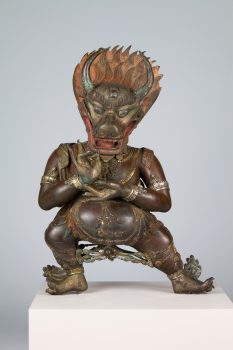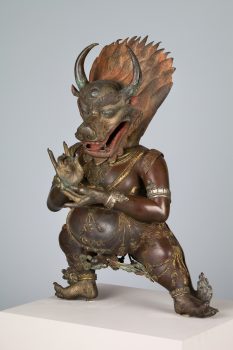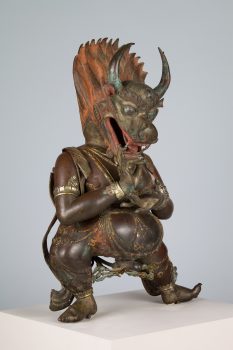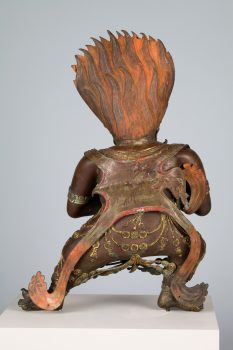Inner Mongolia
19th century




Inner Mongolia
19th century




Vajrabhairava is one of the most important deities of the Geluk School of Tibetan Buddhism, which has dominated Mongolian religious life in recent centuries. This sculpture is assembled from pieces of copper that have been shaped by hammering them from behind, a technique known as repoussé. The joints where the various pieces have been connected are hidden by the figure’s decorative elements such as armlets and bracelets, while the hands and feet were cast separately using the lost wax technique.The artists of Dolonnor, in Inner Mongolia, were masters of repoussé, and in the eighteenth and nineteenth centuries they produced many Tibetan Buddhist images for China’s Manchu imperial court and monasteries across the Tibetan Buddhist world. This sculpture’s separately attached ornaments made of thin strips of hammered copper, such as the elephant skin draped over Vajrabhairava’s shoulder, are characteristic of the Dolonnor style.
A religious movement that originated in India around the fifth to seventh century with sacred writings and esoteric teachings and practices transmitted from teacher to student through initiation. These remain an important part of Hinduism and Buddhism today.
The end of this life marked by the cessation of bodily functions followed by decay. According to Buddhism, after death consciousness transitions to an intermediate state known as the bardo before embarking on another life.
A meditation technique primarily used in tantric practice that involves imagining a deity in one’s mind or imagining oneself becoming a deity and carrying out various activities. Such techniques are intended to help a practitioner transform ordinary perception and achieve enlightened qualities.
Protectors of Buddhist teachings who destroy obstacles that impede the path to enlightenment. The more frightening and gruesome their appearance, the greater their power.
Mongolians have been widely active in the Tibetan Buddhist world, playing a key role in Tibetan culture, politics, and relations with China. In the 13th century, the Mongol Empire—the largest contiguous empire in world history—facilitated the spread of Tibetan visual culture.
Get the latest news and stories from the Rubin, plus occasional information on how to support our work.